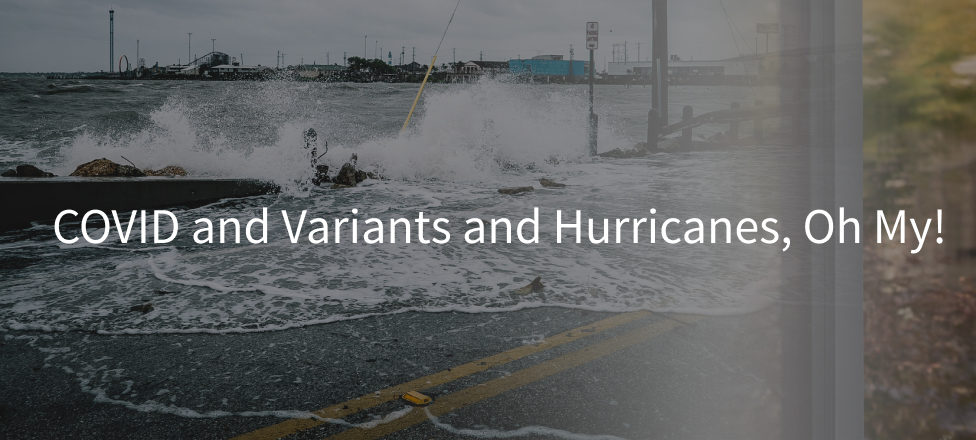

Don’t Let a Focus on COVID Stop These Proactive Hurricane Season Preparations
COVID-19 has dominated the headlines for over a year now, and for good reason. The Coronavirus is the most significant event to change our everyday lives since 9-11. But even as the pandemic drags on, new variants grab headlines and facilities managers remain focused on daily things like disinfection programs, a much more “predictable” eventuality looms in the Atlantic that FMs would be wise to put back on their radar.
Hurricane season.
Yes, hurricane season doesn’t officially start until June 1. But the time for planning and preparing is now, before the season gets underway—a season that’s forecasted to have 17 named storms, by the way.
“This year’s abnormally active hurricane season is all the more reason to adopt a proactive approach to storm prep,” says Jenna Gibson, Client Services Manager for SMI Disaster Recovery Services. “The last thing facilities managers want is to be scrambling to secure their location while a storm is bearing down.”
At SMI, we see this scenario play out the same year after year. A depression forms out in the Atlantic. It gets a name. It grows into a tropical storm, then a hurricane. Storm tracks show where it’s heading. People stampede to hardware stores. Shelves are emptied. Evacuation notices go out. Highways turn into parking lots. The hurricane is mere hours away and then….
“That’s about when we’ll get a call from a frantic and frazzled FM looking for board up and sandbagging,” says Jenna with a smile. “Because of our long-standing relationships and exceptional payment history, we’re typically able to get a crew out to take care of our client. But sometimes, it’s just too late.”
Playing the waiting game to see exactly where the storm will go before taking action presents a slew of problems. One, supplies like wood and sandbags will most likely be hard to come by. Two, board-up crews may already be evacuating. And three, government officials may even be prohibiting movement into certain retail or commercial areas. We couldn’t go in even if a crew was willing.
According to Jenna, a quick, pre-emptive call to SMI at the first indication of a storm’s track goes a long way in making sure we can provide the proper disaster services.
“By calling SMI at the first indication of a storm’s track, we’re able to have crews on stand-by, ready to assess the location, gather materials while they’re still available and be ready to roll should the storm track hold up,” said Jenna. “Our clients are able to relax a bit knowing they’re covered before, during and after a storm.”
Pre-Hurricane Season Planning
Storm tracks aside, Jenna counsels her clients to prepare for a hurricane well before it’s a twinkle in the Atlantic’s eye. There are several important steps facilities professionals can take before the season begins to help mitigate the storm’s cost, disruption, and workload.
Know Your Facilities Inside and Out
Gathering the following information beforehand will help our crews that come to board up and secure a location arrive with the right amount of boards, bags and manpower:
-Get an accurate count of the number of windows and exterior doors at each location.
-Take measurements of each window/door, and document it!
-Verify if storm shutters already exist at the store/facility. If not, consider pre-emptively adding them now.
-Check with the landlord to make sure drilling is allowed around windows.
-If not, it’s a smart idea to invest in board-up clips (Roughly 4 per window).
-Many locations have floor plans. It’s a good idea to find and keep these handy for each store.
-If there is ample storage at the location, consider investing in Quickdam sandbags. They expand when wet, making for easy storing until needed.
-This may seem trivial, but make sure each location has a tape measure on-site so last minute measurements can be made as needed.
-Join our SMI Disaster Recovery Services™ email list to be notified when a storm could impact your location(s).
Sweat the Small Stuff
A little routine preventative maintenance can go a long way when the rain starts coming in sideways:
-Make sure gutters around the facility are clear.
-Check that drains around the facility are flowing.
-Find out if the roof has been inspected lately. It is always smart to establish a baseline.
-Conduct a thorough window and door seal inspection.
-Continue to keep routine maintenance schedules up!
Post-Hurricane Remediation and Restoration
Depending on the severity of the storm, there’s no guarantee when management or staff will be allowed back into the facility. Without someone on the ground right when the clouds part, it could be days before the damage can be fully realized.
Michael DiTaranto, SMI Disaster Recovery Services™ COO, encourages clients to contact SMI well before landfall, so that disaster recovery crews can be ready to start the assessment, remediation and recovery process as early as possible.
“The key is making the call before the hurricane hits,” says Michael. “We can have crews prepped and at your location right away to assess damage, bring down boards, report safety hazards and start the disaster restoration services that will get the store back up and running as fast as possible.”
Even if a location is not necessarily hard hit, it’s important to have an inspection by an IICRC certified flood and mold remediation expert.
“All it takes is a small amount of water inside a facility to cause structural damage, mold, bacteria and more,” says Jenna, who is IICRC Certified in WRT as well. “By the time management and staff are back in, minor water damage could already be causing a major health hazard,”
SMI Leads the Way in Hurricane Disaster Recovery Services
SMI crews are the best in the disaster recovery business. Our services include:
Water Mitigation and Restoration – Minor water damage is hard to see, but can have serious cost ramifications down the road.
Mold & Bacteria Testing & Remediation – It only takes 48 hours for mold to grow. If left unchecked, it could already be a health hazard when staff and customers start coming back.
Fire Restoration – Hurricanes don’t just bring water. Fire is a leading cause of damage after a hurricane.
Build-Back – Whether it’s flood, mold, fire or looting, SMI handles all aspects of quickly bringing locations back to better than before.
At SMI, we pride ourselves on helping our clients expect the unexpected. The key is planning, preparation and operating with a proactive mindset. As the calendar ticks towards June 1, we encourage all facilities professionals to fit some proactive hurricane planning into their already packed calendars.
When (not if) that storm track eventually shows a monster bearing down on one of your locations, a little preparation will go a long way toward peace of mind.